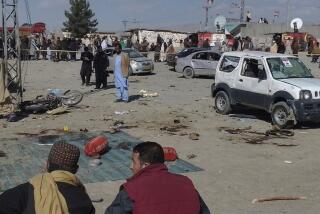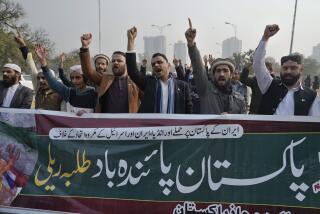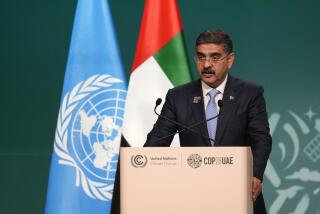Afghan raids illustrate strength of insurgents
- Share via
KABUL, AFGHANISTAN, AND ISTANBUL, TURKEY — In a series of audacious strikes on the eve of the new U.S. special envoy’s scheduled arrival in Afghanistan, Taliban gunmen and suicide bombers on Wednesday staged synchronized raids on three government buildings in the heart of Kabul, killing at least 20 people and injuring scores of others.
The rampage highlighted the ability of insurgents to strike at even the most heavily fortified targets in Afghanistan and was the boldest demonstration yet of declining security in the capital.
It came as the Obama administration, together with NATO allies, is struggling to put together a new strategy for Afghanistan, where Islamic insurgents are gaining ground and many Afghans are disillusioned by the insecurity that pervades their daily lives.
Seven years after the U.S.-led invasion that toppled the Taliban regime, Kabul’s inner districts are a tangle of blast walls and security checkpoints. But insurgents apparently managed to send a squad of at least eight assailants, clad in suicide vests and toting assault rifles, into some of the city’s most secure areas to carry out Wednesday’s attacks, officials acknowledged.
North Atlantic Treaty Organization and U.S. military commanders have repeatedly said Taliban fighters are attempting to create the impression -- unfounded, they say -- that they have the strength to menace the capital at will. To the people of Kabul, though, Wednesday’s attacks were a potent display of the insurgents’ reach and ruthlessness.
“We heard the sound of firing from inside,” said 19-year-old Mohammad Rafiq, who sells clocks and watches from a small storefront across from the Justice Ministry, one of the buildings targeted. “Employees came running out, screaming and shouting for help.”
Chaos ensued as prolonged bursts of gunfire rattled through city streets. Some terrified government workers jumped from second-story windows to escape. As police arrived and opened fire on the assailants, motorists did screeching U-turns to escape the fighting. Shopkeepers hastily shuttered their establishments amid the wail of sirens.
The justice minister was trapped for a time in his office as fighting raged in the corridors. The minister, H.E. Sarwar Danish, told the Associated Press by cellphone during the siege that the attackers were armed with grenades and assault rifles. The fighting continued for more than an hour before the ministry was secured.
A Taliban spokesman, Zabiullah Mujahid, said the attacks were meant to avenge the alleged torture of insurgents in prison. Speaking by telephone from an undisclosed location, he boasted that similar assaults could be carried out at any time.
Some of the fighting took place a short distance from the presidential palace, where Richard Holbrooke, the newly minted American special envoy to the region, is likely to visit. On Tuesday, the White House said it planned to complete an overhaul of policy on Afghanistan and Pakistan by April; U.S. military commanders, meanwhile, have said they could send an additional 30,000 troops to the troubled country this year, nearly doubling the American contingent.
Holbrooke’s schedule was not announced for security reasons, but Afghan officials had said he was expected in Kabul today.
Holbrooke has been in Pakistan, where he traveled by helicopter Wednesday to the lawless tribal areas to see the positions of Pakistani troops battling the Taliban on their side of the Afghan-Pakistani border.
While Holbrooke was visiting Peshawar, the main city in Pakistan’s troubled northwest, suspected insurgents killed a lawmaker from a secular party. The parliament member, Alam Zeb Khan of the Awami National Party, was fatally injured when his vehicle passed by a remote-controlled bomb hidden in a motorcycle.
In Afghanistan, securing the provinces adjoining Kabul has become a high priority for Western military commanders. More than 3,000 U.S. troops have been deployed in the last month in Logar and Wardak provinces, just to the south of the capital, after militants established a firm foothold there, cutting off traffic on the country’s main highway.
After hours of contradictory reports about casualties in the Kabul attacks, the interior minister, Mohamad Hanif Atmar, said 20 people had been killed and 57 hurt, some of them critically. The dead included nine members of the Afghan security forces and 10 civilian workers at the Justice Ministry, Atmar told reporters.
Earlier, other officials said eight assailants were killed, although it was not clear where or how they died.
Targeted installations included the Education Ministry and an office of the prisons department. The use of multiple suicide bombers is not a new tactic for the Taliban, but in a departure from past practice, the assailants apparently tried to kill as many people as possible with gunfire before setting their explosives. At least three succeeded in blowing themselves up after the initial assault with grenades and gunfire, according to early reports.
Afghan officials said the attacks were masterminded in Pakistan. Atmar said that just before the assault, the gunmen sent text messages to a Pakistani handler. Afghanistan has long accused Pakistan’s main spy agency, Inter-Services Intelligence, or the ISI, of aiding insurgents. In a claim backed up by U.S. intelligence, Afghan authorities blamed the ISI for aiding militants who bombed the Indian Embassy in Kabul last summer, killing about 60 people.
President Hamid Karzai condemned the new attacks, saying militants sought only “opportunities to kill innocent Afghan people.”
Although all Afghan government buildings are heavily fortified, they present temptingly high-profile targets for the insurgents. In October, Taliban militants stormed the Ministry of Information and Culture in Kabul, killing five people.
This month, Afghan authorities announced that they had broken a Taliban suicide-bombing cell that had carried out a dozen attacks in the capital over the last 22 months, including one weeks earlier that killed a U.S. soldier and wounded five others. But they said at the time that some of the organizers remained at large.
--
Faiez is a special correspondent. Special correspondent Zulfiqar Ali in Peshawar contributed to this report.
More to Read
Sign up for Essential California
The most important California stories and recommendations in your inbox every morning.
You may occasionally receive promotional content from the Los Angeles Times.










